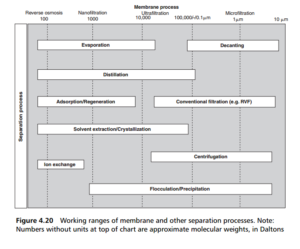0
-
An empty cart
You have no item in your shopping cart
envato-wordpress-toolkit domain was triggered too early. This is usually an indicator for some code in the plugin or theme running too early. Translations should be loaded at the init action or later. Please see Debugging in WordPress for more information. (This message was added in version 6.7.0.) in /var/www/wp-includes/functions.php on line 6121g5plus-darna domain was triggered too early. This is usually an indicator for some code in the plugin or theme running too early. Translations should be loaded at the init action or later. Please see Debugging in WordPress for more information. (This message was added in version 6.7.0.) in /var/www/wp-includes/functions.php on line 6121The availability of inexpensive membrane materials has revolutionized pure water production, and provided one of the largest markets for such materials. There is now a relatively straight trade-off between the desired purity of the product water and the money available to achieve that purity.
There are four main processes utilizing membranes for the separation of impurities from water. Two of these, microfiltration and ultrafiltration, as their names imply, work by a filtration process, i.e. they present a porous barrier to the flow of a suspension of solid or semi-solid material, which allow some of the solid to pass through the barrier, entirely according to the size of the suspended material. The other two membrane processes, reverse osmosis and nanofiltration, do not have physical holes in their structure, but work by diffusion, i.e. the species to which the membranes are permeable move at the molecular scale through the structure of the membrane.
Their separation functions overlap to some extent, although the centre points of their working ranges are quite distinct, as shown in Figure 4.20 . The processes are differentiated by their range of separation cut-points and normal duties:
reverse osmosis: 25 to 300 Daltons, retaining quite small molecules, small ions
nanofiltration: 150 to 15,000 Daltons, retaining somewhat larger molecules and most ions
ultrafiltration: 5000 to 200,000 Daltons or above (up to 0.1um), retaining large
organic molecules and colloidal solids
microfiltration: 0.05 to 3um or above, retaining fine solid particles
The different cut-points are directly related to the driving pressure required to achieve them. While most microfiltration and some ultrafiltration need little more

than 1 bar of transmembrane pressure, reverse osmosis processes may require as much as 50 or 60 bars. Clearly reverse osmosis becomes an expensive process to operate at this level, but it is still the best way to achieve ultra-pure water, when
coupled with a deionization system to remove the ions that get through the reverse osmosis membrane.
Continuous electrodeionization technology uses mixed bed ion exchange resins and selectively permeable membranes to extract dissolved salts from water under the influence of an electric field. This field drives the ions away from the products
flow and continuously regenerates the resin beads, avoiding the need for chemical regeneration. The combination of reverse osmosis and electrodeionization is claimed to be the safest and most reliable way to produce purified water.
It is very important to remove suspended solid particles ahead of membrane processes, especially those using hollow fibre or spiral wound modules, or the particles are likely to block the narrow flow passages. For large flow rates, a suitable filter for this purpose would be a deep bed filter, whereas for smaller flows, polishing cartridges with pleated or thick media can be used.
The normal chlorine treatment of water kills bacteria and fungi to a large degree, and a prefilter and reverse osmosis complete the process. However, bacteria thrive on the resins used in ultra-pure water systems, requiring that the systems be sterilized periodically. In between sterilizations, cartridge polishing filters can be used to trap any bacteria remaining in the system. Decaying vegetable and animal matter release long chain organic molecules into municipal water supplies, of which most are removed by a reverse osmosis system. In extreme cases, special resins and activated carbon beds may also be required.
Ultra-pure water is quite corrosive and it attacks the transport lines, valves and other system components, producing particulates downstream of the polishing filter. A point-of-use filter rated at 0.2um or a small ultrafiltration system should therefore be used. The complexity thus implicit in an ultra-pure water system is illustrated in Figure 4.21 , which also shows a recycle stream of used wash water.
The most important performance characteristics for final filtration cartridges used in ultra-pure water production are as follows:
● the minimum possible migration of particulates and ions from the cartridge itself (fibre releasing materials must not be used in these filters)
● lowest possible initial pressure drop, since pressure drop in the filter system represents lower pressure availability at the point of use
● highest throughput for maximum economy, and
● quickest rinse-down after cartridge change, to minimize waste of water and time.